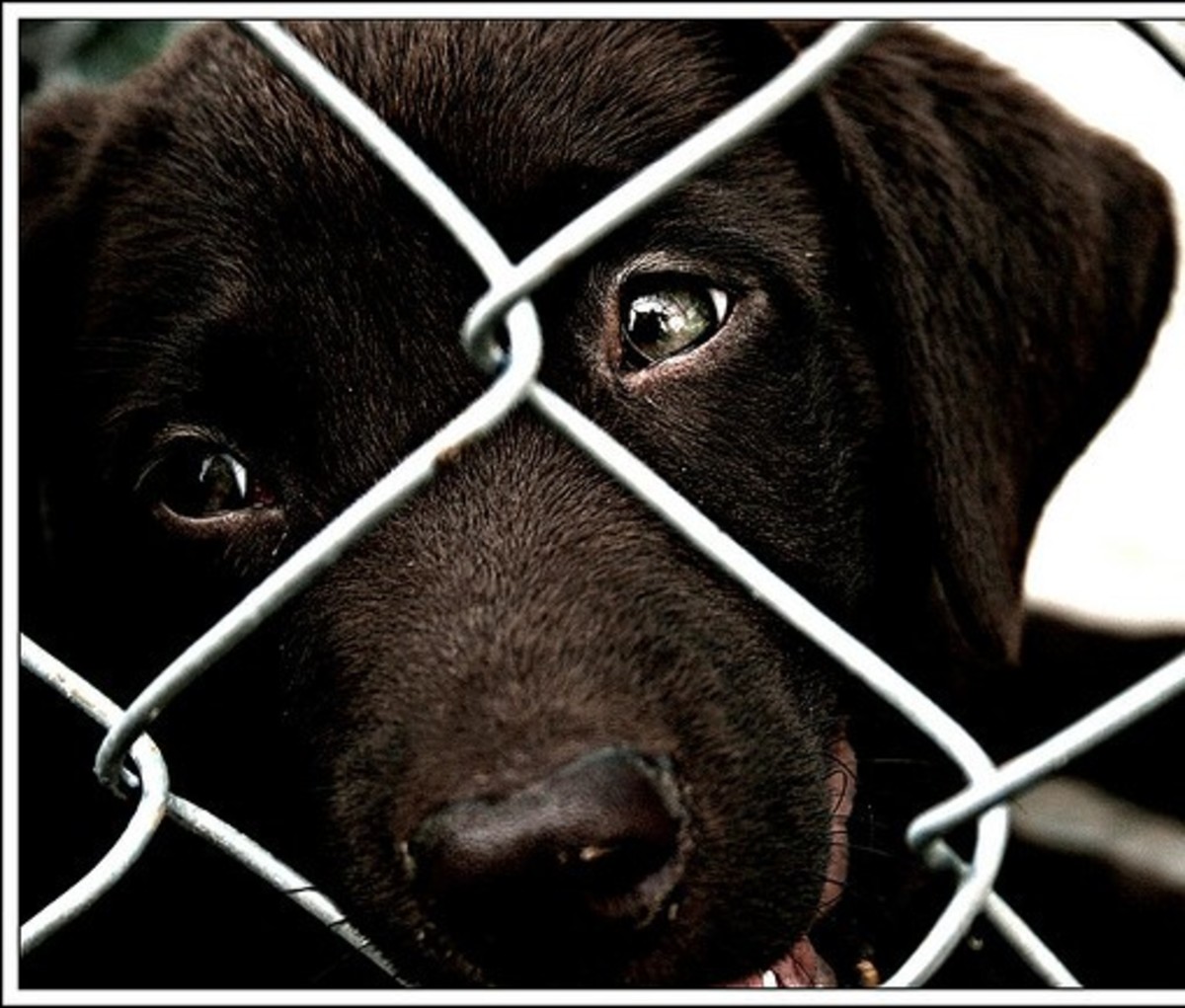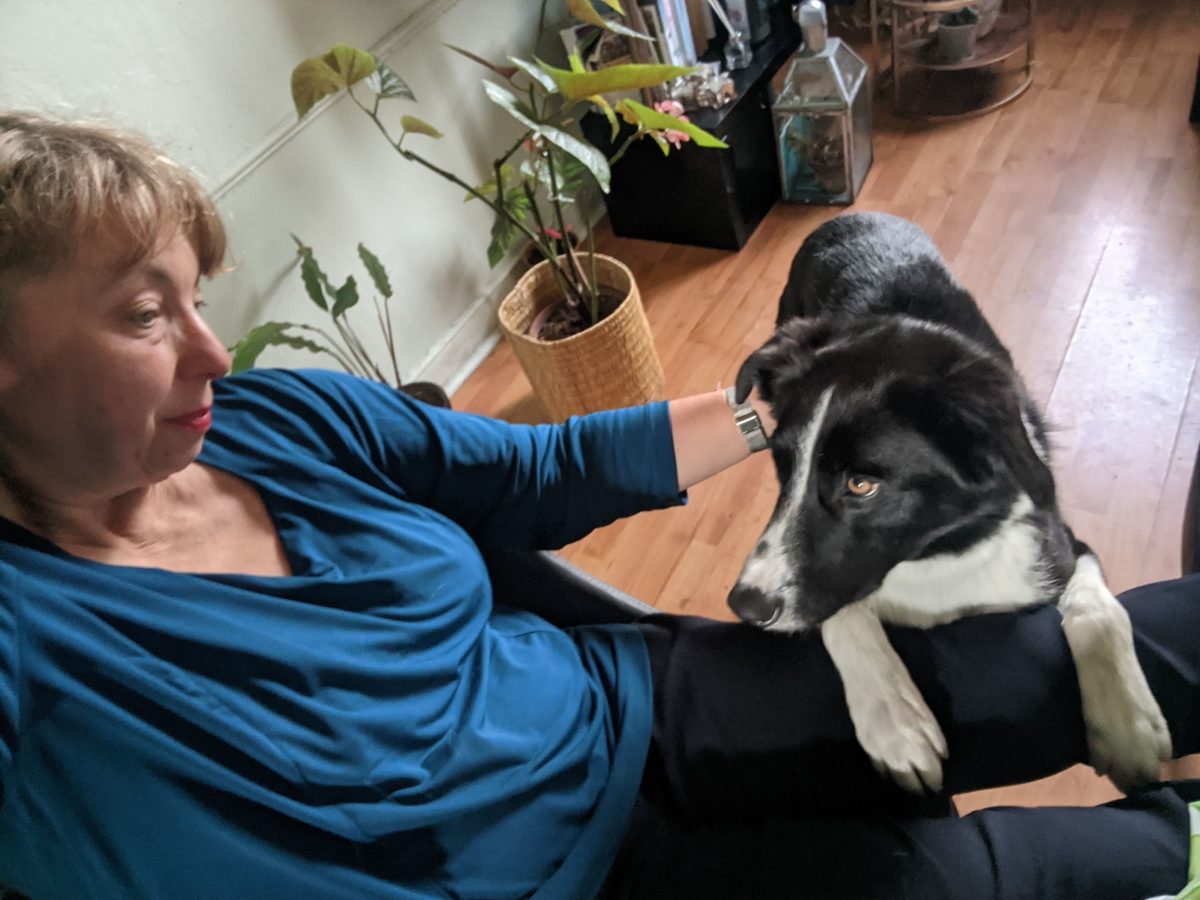Understanding The Great Puppy Mill Rescue Debate - To Spend or Not to Spend
My own puppy mill rescues
I have two puppy mill rescues. Both are Cavalier King Charles Spaniels (CKCS).
Callie is a former breeding mama who came to us straight off the farm October 2016 when she was six years old. Charlie is now ten months old and arrived, again straight out of the mill, in late May of 2017.
We didn't set out to rescue a puppy mill dog. My wife and I had a difficult time with a previous dog, but I was lonely with just cats, and I remembered my childhood best friend - a Cavalier King Charles Spaniel named Gertie. She was a former breeders dog whom we acquired at eight years old (same age as me at the time!)
I convinced my wife that we should start looking at Cavaliers. We knew we couldn't afford a puppy from a breeder and, quite frankly, didn't want a pup if possible. One day, Callie and another female popped up on Petfinder in VT!
I called the rescue immediately and found out about both girls. Each was approximately six years old and just back from a trip out to Ohio to rescue 18 dogs from Amish puppy mills out there. We made plans to see the one with whose photo my wife fell in love. Callie wormed her way into our hearts, and we slowly but surely, taught her that humans could love.
Callie had never seen a dog bed, a toy, a bone. She didn't know how to play, be petted, or cuddled. Callie had never seen grass or walked on a leash. The first time she got a bone may have been the most exciting moment in her life.
Watching Callie change and grow was an incredible experience, so much, so it inspired me to begin blogging about it, on Callie's Wag, and I haven't stopped writing about her, puppy mills, and rescue since.
After Charlie came along, writing about puppy mills became even more important to me as he arrived at three months as a "puppy mill reject;" meaning he had too many health problems to sell or use as a stud. He was a throwaway.
When Charlie arrived, and we met him, sweet as could be and reeking of a smell you cannot possibly imagine unless you have been near a mill or a rescue. A mixture of poop, piss, dirt, drool, food, and who knows what else. The rescue told us he had a slight heart murmur, could be a puppy murmur and go away, but he is a Cavalier, and they are prone to heart murmurs, he had an umbilical hernia, and he has luxating patellas or kneecaps that slide in and out of place.
That last one, that's likely to be expensive in the end. While we have been doing everything we can to prevent issues in the future, feeding Charlie high-quality food, exercise, hill climbs to build up his back muscles, etc., his right hind leg is worse and will be problematic. And that heart murmur hasn't gone away.
However, we knew all of his health problems going in, so in that, we were lucky; most people don't have that chance.
The rescue we got both of our dogs through works with three specific Amish puppy mills in Ohio and, while they only go out twice a year, they pay a nominal "freedom price" to keep each dog alive until it is time for them to make their next trip. They always bring back mill dogs, but throughout the year will occasionally bring dogs up from the south as well.
Sounds like a decent stop-gap measure, right? Not everyone thinks so. Are those of us who rescue puppy mill dogs continuing to feed into the mill cycle? And if so, what is to be the fate of those dogs?
Callie, the day we met her

Charlie the day we met him

What is a puppy mill and why the Amish?
A quick rundown of what a puppy mill looks like -
- Overcrowding and inadequate access to even the most basic veterinary care are prevalent in these types of operations, leading to widespread cases of disease, negligence, and malnutrition.
- Medical conditions such as tumors, birthing complications, respiratory infections, flea infestations, heartworms, and digestive problems go untreated and are common side effects of the lack of care and the unsanitary environment.
- The females are used as little more than tools for holding puppies. Once they are physically depleted to the point where they are unable to reproduce anymore, they are often killed and disposed of to make room for new females. The male dogs used for stud fair no better. http://www.cchs-petshelter.org/
We often envision these as large-scale breeding enterprises with hundreds upon hundreds of crates stacked upon each other in large warehouses, barns, or even fields. But puppy mills don't have to be big to be bad.
According to Aubrie Kavanaugh of Paws4Change.com,
"people have the idea that mills are located in some far away place and that most of them are in the Midwest. The unfortunate truth is that puppy mills are becoming a pervasive problem in most states.
The commonly accepted definition of a puppy mill is a dog breeding facility that keeps so many dogs that the needs of the breeding dogs and puppies are not met sufficiently to provide a reasonably decent quality of life for all of the animals."
Many people run smaller mills out of their houses. News reports will occasionally filter in of animal control seizures of anywhere from 50-150 dogs from someone's home. Usually, these dogs range in age from puppy to adult and maybe all one breed or mixed. There is often an assumption that these individuals are hoarders, who knows, they may be, but they are also puppy millers.
The puppies are most likely removed from their mothers at six weeks of age and sold through newspaper ads, in parking lots, over the internet, or through brokers who then sell the puppies to pet stores.
So, why the Amish?
Puppy farming, as it is also called, isn't solely restricted to the Amish communities, however, the Amish are some of the most prevalent puppy millers there are.
The Amish believe dogs are livestock just like any other creature and animals were put on Earth by God to serve man. Before I continue - the majority of the Amish community does not support puppy mills, in fact, many are horrified and fight against them as well, but a large percentage run them, according to an ABCNews piece by Sharon Alfonsi and Ted Gerstein.
This belief allows many puppy millers to argue that, given that dogs are livestock, they should be a source of income.
Missouri holds the most dog auctions
A dog auction is held about once a month.
At any given auction 200-300 dogs are listed.
Between "breeders" and rescues, one auction brought in $500,000 for Southwest Auction Service and the millers selling their dogs.
What's the problem with rescuing mill dogs?
According to the Clark County Humane Society in Clark County, Missouri, there are anywhere between 2,000 and 3,000 USDA-licensed breeders operating in the United States. Some of these operations can be so large that they contain 1,000 breeding dogs at the same time.
What's not included in that figure is the number of unlicensed puppy mills that exist; the ones the USDA has not approved and does not know about.
To some, the answer might seem simple; there are dogs in need of saving and we, as humans, are responsible for helping these animals.
To others though, it's not quite as easy an answer. Most rescues have to pay some money to the puppy mills to either save the dogs until the rescuers can get out to where the animals are, or they go to mill dog auctions and purchase dogs.
The rescue Callie and Charlie both came through is based here in Vermont and only makes trips out to the Ohio area twice a year. During the interim, the rescue pays a (relatively) small freedom price to keep each dog alive until they make their next trip.
That's just one way though.
There are a good number of rescues who raise money to spend at dog auctions, rescuing mill dogs. Often these are breed-specific rescues, but not always. For a good while, I was in support of this as well because I have puppy mill survivors, but then I began to read more on the topic.
According to Kim Kavin, author of The Dog Merchants: Inside the Big Business of Breeders, Pet Stores, and Rescues, during an interview with Meghan Christensen of Forbes Magazine,
"Deep-pocketed rescuers — those who can raise a lot of money online through sites like GoFundMe — have been known to spend more than $6,000 per dog as well. In 2014, Alabama rescuers raised more than $220,000 from online donors to buy dogs at auction. The purchase was called a “rescue effort” in the media."
And this is where the problem lays. If rescuers are paying up to or more than $6,000 on a single dog, most of that money, minus any fees to the auctioneer or brokers, is going back into the pocket of the owners of the puppy mills.
"Calling the purchase of a dog from any breeder or auctioneer a "rescue" is simply an inaccurate use of that word. Rescue means "to save," not "to buy."
What is happening in these auctions is, in fact, a business transaction. It is breeders and rescuers engaging in the same exact business practice, no matter what label anybody tries to slap on it to make it sound different."
— Kim KavinThe other side of the story
Why do these rescues do what they do?
- The first goal, according to most rescues, is to get the dogs out of the hands of the puppy millers and safe into foster or forever families.
While many are breed-specific, often those are the breeds that are "in fashion" at the moment and more heavily bred than others. For instance, Cavaliers have regained popularity over the last 10-20 years, and now there is a large number of Cavalier-specific rescues.
- The second is for education and awareness. Without access to individual rescue dogs and their stories, it can be harder to get some people to listen to you.
I don't know about you, but whenever that Sarah MacLaughlin ASPCA commercial comes on the TV (rarely now with the advent of streaming), I have to change the channel. I can't watch it.
Isn't that a terrible thing for a rescue advocate to say? I still can't watch videos; I can't even watch puppy mill videos. But, what I can do and will do is read about each dog and their story, the more these are shared, the more people slowly can handle the snippets of information that matter to get them to understand.
"[Rescue workers] had two concerns about the tiny white Maltese numbered B-16. The first was that she was in wretched health: her jaws were rotting away from far-gone infections, her coat was so thin she was almost bald, and her legs were barely strong enough to walk. The second was that she was end-stage pregnant: she wound up giving birth to two tiny puppies on the truck to the staging shelter." - Paul Solotaroff
""I have never cried so much in my entire life! Every time she learns something new, that it seems all dogs should know all along, like what a treat is, or a warm bed, you can see the utter joy in her eyes." - Rescue owner
"[When we met] You looked scared beyond belief but you rose above your fear to protect your fellow adult rescue, cutting her off to keep her from pacing too close to the wires where she would jump up and cut her feet. That’s who you are. A lover, a protector of other animals, despite whatever possible abuses you had experienced at the puppy mill where you had been churning babies out for years." - Rescue owner.
"...after spending 10 years living in a cramped, filthy cage in a puppy mill – where he’d lost an eye when his cage was power-washed, Harley was finally freed. He immediately received much-needed medical care and found love with a special family. And he thrived. To the surprise of the veterinary community, this strong-spirited little 6-pound Chihuahua continued going strong in spite of medical conditions which were the result of his years living in a cage. For five years following his rescue, Harley worked hard educating children and adults alike about puppy mills." - Harley's Dream
From a rescuer, "I have never kept track of my rescue work hours, but it is certainly around the clock from the moment I open my eyes until I fall asleep. If I had to make a best guess, I would say on average about 60 hours a week with there being times of heavy intake when we put forth much more than that."
"9\16\17 is the day she was thrown up on the auction block, listed as a breeder, covered in matted fur, a mouth full of rotten teeth, and her eyes swollen shut from infection. [When I got her] she was still recovering from surgery at the time and required meds, and we are still treating the eyes (I’m betting that will be lifelong)..."
As a result of these stories, people have been able to find supporters for legislation that will help prevent puppy mills.
One such story, that of Lucy the Rescue Cavalier, caught the attention of both celebrities and MP's in England who then supported Lucy's Law. Lucy's Law called for the ban on the sale of puppies without the mother present, to help put an end to the commercial dog industry.
- Just last week the Prime Minister of England officially banned the sale of puppies without the mother present, bringing joy to all who have worked so hard on Lucy's Law. But that doesn't mean anyone is going to stop, the momentum has started now, and legislation is changing in various places.
- In California, starting in January 2019, pet stores will only be allowed to sell cats, dogs, and rabbits from animal shelters, rescue groups, or adoption centers.
- In Australia, strong legislation has just passed regarding the number of females, the pet shops needing to sell only rescue/shelter animals, and more.
"As a result of years of neglect I had discoloured fur on my legs from the urine and faeces I had been kept in. My fur and skin had a burnt odour to them which was a result of the ammonia in the urine burning my skin.
In addition, I suffered with bald patches to my fur, fused hips and an extremely arched back, to the extent my back feet nearly touched my front!
I was very underweight, weighing in at a tiny 3.5 kg when I was rescued, less than half of what most Cavaliers generally weigh."
— Lucy the Rescue CavalierLucy the Rescue Cavalier


What are the options?
Some rescues, such as the National Mill Dog Rescue, do not ever pay for the dogs they bring in. Instead, they say "as stated on our homepage, we do not pay the mills to rescue their dogs. These dogs are given to our rescue contacts and in turn, given to us. These are dogs that would otherwise be killed as they are no longer useful to the mill."
Some individual rescuers/rescues develop long-term relationships with millers and can get these people to give them their older/injured/unwanted dogs for free.
Some are at least able to get the dogs for a nominal fee.
But, the question is, at what point does it stop being an ethical rescue and start being a "purchase," particularly in the eyes of the puppy mill owner?
I don't have the answer. I can't say I don't support the rescue our dogs came from, but I also don't agree with rescues paying thousands of dollars at dog auctions.
Perhaps the answer is to stop going to dog auctions altogether. Breed-specific rescues would find themselves limited for a while until they figured out other options, but maybe that would encourage the rescuers to try and develop valuable relationships with the millers to rescue their older/unwanted dogs for free?
But, without the rescuers, some of the above legislation wouldn't have come about. Without these rescues, we wouldn't have the voices that catch peoples' attention. I can talk and talk and talk, but one photo - it's retweeted hundreds of times. The number of tweets with photos of animals supporting Lucy's Law must have been in the thousands. They couldn't be ignored.
I'm not going to stop talking, writing, tweeting. Maybe I am part of the problem. But I'd like to think all my advocacy is for something. I'd like to think I'll help bring legislation to the US by talking about my dogs and others.
But the answer as to how to handle puppy mills and rescues? That one I'm still on the fence about.
Callie now

ABCNews Article by SHARYN ALFONSI and TED GERSTEIN
- Puppies 'Viewed as Livestock' in Amish Community, Says Rescue Advocate - ABC News
"Dogs in this community are viewed as livestock," Smith said. "Nothing more. Chickens or pigs or goats. It's just a source of income for them."
Paws4Change
- Blog - Paws4Change - Paws4Change®
But what about how we behave as rescuers and advocates? Are we really any better than the public we are so quick to judge?
Interview with Kim Kavin by Meghan Christensen of Forbes Magazine
- Dogs For Sale: The Business Of Dog Auctions
The $11 billion global dog-buying industry is fueled by dog auctions, often in the middle of America. Here's a look at the tangled web of breeders and rescuers.
© 2017 Molly O'Hara








